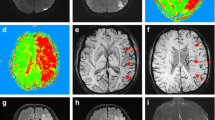Abstract
Brain ischemic lesions identified by diffusion-weighted imaging (DWI) have been shown to predict high risk of early future ischemic events in patients with transient ischemic attacks and minor stroke. The aim of this study is to analyze different brain MRI–DWI patterns in patients with mild-moderate stroke to define acute patterns related with a higher risk of stroke recurrence in long-term follow-up (from 6 to 36 months). Retrospective review of case series from a prospective stroke record including 253 patients with mild-moderate stroke (NIHSS from 1 to 7) and acute MRI–DWI lesions. MRI–DWI lesions were analyzed to determine clinically relevant lesions, based on the number, location, age and affected arterial territories. We defined three patterns: (1) multiple versus single lesions; (2) single deep versus single cortical lesions; and (3) single lesions versus multiple lesions affecting different arterial territories and/or of different age. The impact of these patterns on recurrence was analyzed by Cox regression analysis. 38 patients (15.0%) suffered a recurrence. Univariate analysis showed the risk of recurrence for each pattern. Pattern 1: patients with multiple lesions had greater risk of recurrence than those with single lesions (28.2 vs. 9.9%; OR: 3.75 (95% CI: 1.76–7.27), p < 0.0001). Pattern 2: patients with single cortical lesions had higher risk than those with deep lesions (14.3 vs. 6.7% OR: 2.33 (95% CI: 0.86–6.33), p < 0.089). Pattern 3: patients with multiple DWI in different territories or different age had the highest recurrence rate (30.6%), OR: 4.01 (95% CI: 1.70–9.47), p < 0.001, compared to patients with single lesions. Cox regression analysis adjusted by possible confounders, showed that for pattern 1 the OR for recurrence was 2.49 (95% CI: 1.27–4.89), p = 0.008; for pattern 2, OR:1.99 (95% CI: 0.74–5.37), p = 0.17; for pattern 3, OR: 2.85 (95% CI: 1.31–6.15), p = 0.008. Brain MRI–DWI patterns assessed in the acute phase of mild-moderate stroke are useful to identify those patients at high risk of recurrence.


Similar content being viewed by others
References
Adams HP Jr, Bendixen BH, Kappelle LJ et al (1993) Trial of Org 10172 in acute stroke treatment. Classification of subtype of acute ischemic stroke: definitions for use in a multicenter clinical trial. Stroke 24:35–41
Aho K, Harmsen P, Hatano S, Marquardsen J, Smirnov VE, Strasser T (1980) Cerebrovascular disease in the community: results of a WHO collaborative study. Bull World Health Org 58:113–130
Coutts SB, Hill MD, Simon JE, Sohn CH, Scott JN, Demchuk AM, for VISION Study Group (2005) Silent ischemia in minor stroke and TIA patients identified on MR imaging. Neurology 65:513–517
Coutts SB, Simon JE, Eliasziw M et al (2005) Triaging transient ischemic attack and minor stroke patients using acute magnetic resonance imaging. Ann Neurol 57:848–854
Goldstein LB, Samsa GP (1997) Reliability of the National Institutes of Health Stroke Scale: extension to non-neurologists in the context of a clinical trial. Stroke 28:307–310
Kang DW, Latour LL, Chalela JA, Dambrosia J, Warach S (2004) Early and late recurrence of ischemic lesion on MRI. Evidence of a prolonged stroke-prone state. Neurology 63:2261–2265
Kang DW, Latour LL, Chalela JA, Dambrosia JA, Warach S (2003) Early ischemic lesion recurrence within a week after acute ischemic stroke. Ann Neurol 54:66–74
Lansberg MG, Thijs VN, O’Brien MW et al (2001) Evolution of apparent diffusion coefficient, diffusion-weighted, and T2-weighted signal intensity of acute stroke. Am J Neuroradiol 22:637–644
Ois A, Cuadrado-Godia E, Jiménez-Conde J et al (2007) Early arterial study in the prediction of mortality after acute ischemic stroke. Stroke 38:2085–2089
Ois A, Gomis M, Rodríguez-Campello A et al (2008) Factors associated with a high risk of recurrence in patients with transient ischemia attack or minor stroke. Stroke 39:1717–1721
Purroy F, Montaner J, Rovira A, Delgado A, Quintana M, Álvarez-Sabín J (2004) Higher risk of further vascular events among transient ischemic attack patients with diffusion-weighted imaging acute ischemic lesions. Stroke 35:2136–2313
Redgrave JN, Coutts SB, Schulz UG, Briley D, Rothwell PM (2007) Systematic review of associations between the presence of acute ischemic lesions on diffusion-weighted imaging and clinical predictors of early stroke risk after transient ischemic attack. Stroke 38:1482–1488
Rothwell PM, Giles MF, Chandratheva A et al (2007) Early use of existing preventive strategies for stroke (EXPRESS) study. Effect of urgent treatment of transient ischaemic attack and minor stroke on early recurrent stroke (EXPRESS study): a prospective population-based sequential comparison. Lancet 370:1432–1442
Schulz UG, Briley D, Meagher T, Molyneux A, Rothwell PM (2003) Abnormalities on diffusion weighted magnetic resonance imaging performed several weeks after a minor stroke or transient ischaemic attack. J Neurol Neurosurg Psychiatry 74:734–738
Sylaja PN, Coutts SB, Subramaniam S, Hill MD, Eliasziw M, Demchuk AM (2007) VISION study group. Acute ischemic lesions of varying ages predict risk of ischemic events in stroke/TIA patients. Neurology 68:415–419
Wen HM, Lam WW, Rainer T et al (2004) Multiple acute cerebral infarcts on diffusion-weighted imaging and risk of recurrent stroke. Neurology 63:1317–1319
Acknowledgments
This study was funded in part by the Ministry of Health, Instituto de Salud Carlos III (Red HERACLES RD06/0009).
Conflict of interest statement
The authors have reported no conflicts of interest.
Author information
Authors and Affiliations
Corresponding author
Rights and permissions
About this article
Cite this article
Roquer, J., Rodríguez-Campello, A., Cuadrado-Godia, E. et al. Acute brain MRI–DWI patterns and stroke recurrence after mild-moderate stroke. J Neurol 257, 947–953 (2010). https://doi.org/10.1007/s00415-009-5443-5
Received:
Revised:
Accepted:
Published:
Issue Date:
DOI: https://doi.org/10.1007/s00415-009-5443-5




